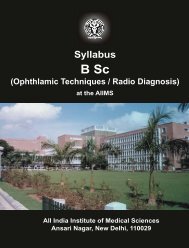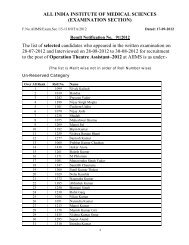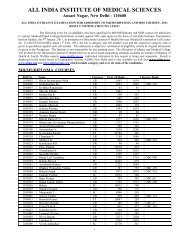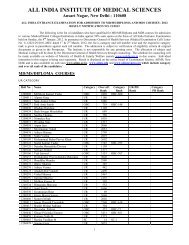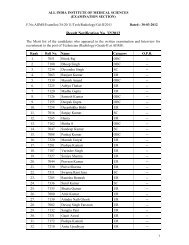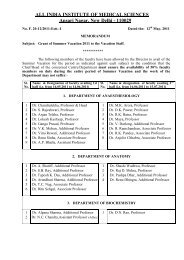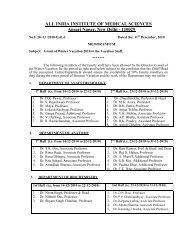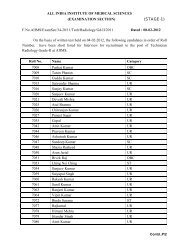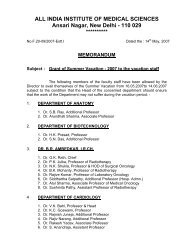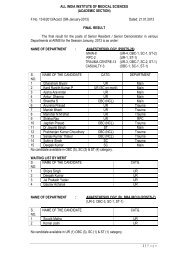Manual for long-term pharmacotherapy - All India Institute of Medical ...
Manual for long-term pharmacotherapy - All India Institute of Medical ...
Manual for long-term pharmacotherapy - All India Institute of Medical ...
You also want an ePaper? Increase the reach of your titles
YUMPU automatically turns print PDFs into web optimized ePapers that Google loves.
the patient's occupational and social functioning, improve the economic status <strong>of</strong> patients and their families<br />
and ultimately to achieve abstinence from drug use, including cessation <strong>of</strong> the opioid substitution treatment.<br />
<strong>All</strong> <strong>of</strong> these objectives will not necessarily be achieved with each patient and may not be achieved to the same<br />
degree.<br />
Pharmacology<br />
Mechanism <strong>of</strong> Action<br />
Buprenorphine is a partial µ agonist and k antagonist, which has a relatively <strong>long</strong> duration <strong>of</strong> action. It is a<br />
semi-synthetic opium alkaloid derived from thebaine and is structurally related to its narcotic antagonist<br />
etorphine and diprenorphine. It is a <strong>long</strong> acting, highly lipophilic opioid and 25-50 times more potent than<br />
morphine (in analgesic action). It produces analgesia and other central nervous system effects that are<br />
qualitatively similar to those <strong>of</strong> morphine. Buprenorphine binds to more than one opioid receptor. It has<br />
higher affinity and low intrinsic activity at opioid receptor. Buprenorphine can substitute <strong>for</strong> morphine or<br />
heroin and suppresses symptoms <strong>of</strong> agonist withdrawal. However, at very high levels <strong>of</strong> addiction, it may<br />
precipitate withdrawals.<br />
At low doses buprenorphine in humans produces morphine like subjective, physiological and behavioural<br />
effects. These include analgesia, sedation, pupillary constriction and euphoria. When the dose <strong>of</strong><br />
buprenorphine is increased, the intensity <strong>of</strong> its actions does not seem to exceed that achieved with 30-60 mg<br />
morphine. When given sublingually, morphine like subjective effects (euphoria) reached a ceiling at about 8-<br />
16 mg. The pharmacokinetic data revealed dose-related increase in plasma concentration <strong>of</strong> buprenorphine,<br />
indicating that the apparent ceiling on the effects <strong>of</strong> buprenorphine was not attributable to limited sublingual<br />
absorption. For all measures, there was a ceiling dose, beyond which no greater effect was observed.<br />
Respiration was maximally suppressed after administration <strong>of</strong> 16 mg buprenorphine. The ceiling effect on the<br />
euphoria and respiratory depression respectively limit abuse liability and increase the safety in clinical<br />
practice. The potential <strong>for</strong> lethal overdose is remote even at 10 times <strong>of</strong> the therapeutic dose. Moreover, due to<br />
its partial agonistic action, it can precipitate withdrawal in morphine dependent individuals. Following<br />
repeated administration, buprenorphine attenuates or blocks the subjective effects <strong>of</strong> parenterally<br />
administered morphine or heroin.<br />
It binds tightly to and slowly dissociates from the receptors and its slow rate <strong>of</strong> dissociation contributes to<br />
buprenorphine's <strong>long</strong> duration <strong>of</strong> action. For this reason its effect can be prevented by prior or simultaneous<br />
administration <strong>of</strong> narcotic antagonists rather than later.<br />
Pharmacokinetics<br />
Buprenorphine is less effective by oral route and its bioavailability by this route is 15 percent but when<br />
administered sublingually, its bioavailability increases to 51 percent. There is no limit in sublingual absorption<br />
and plasma concentration is linearly related to dose. Peak blood levels are achieved after 5 min when<br />
administered through i/v route. It is metabolised in liver by glucoronide conjugation and<br />
25




